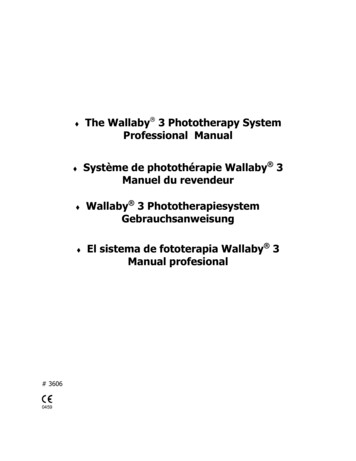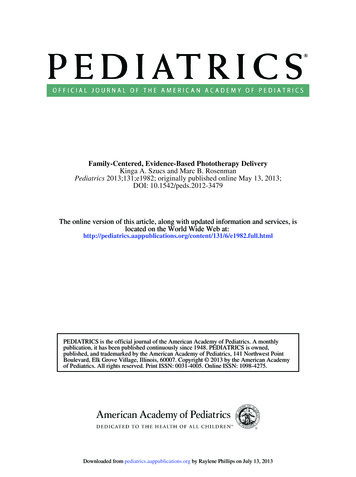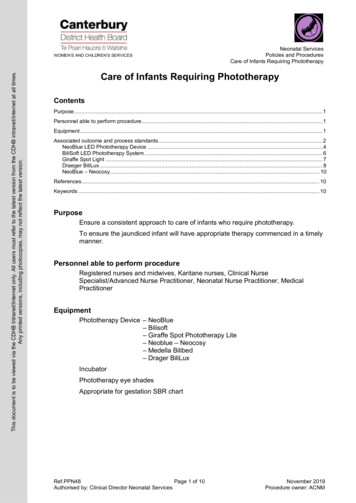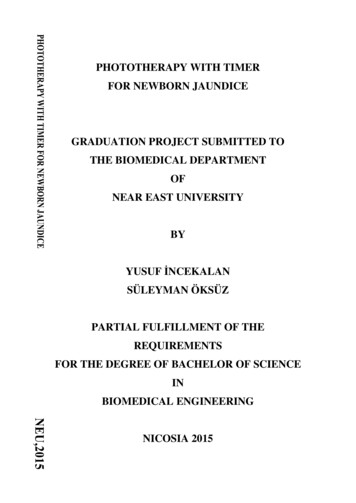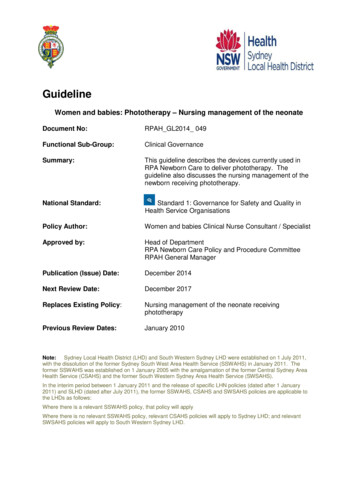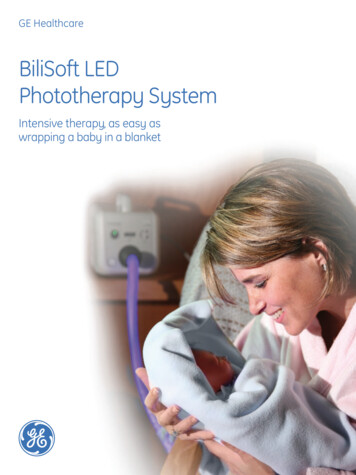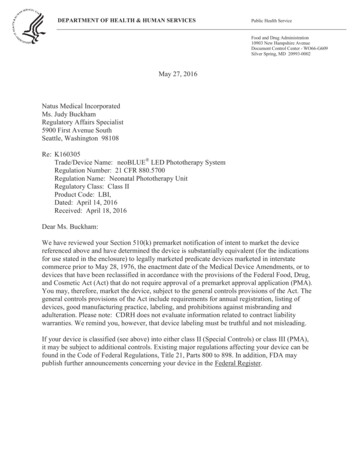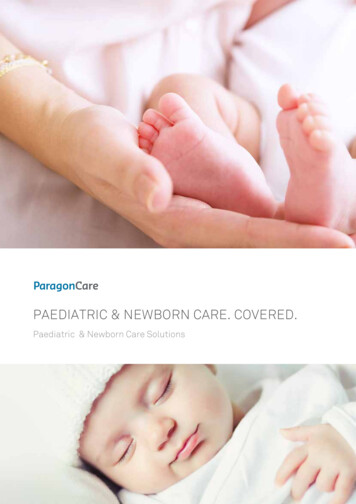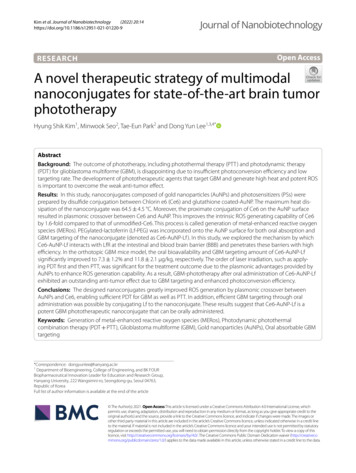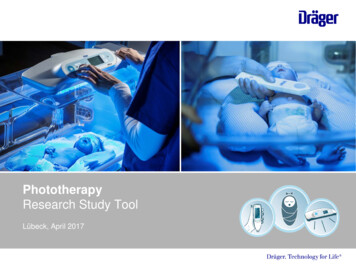
Transcription
PhototherapyResearch Study ToolLübeck, April 2017
How the tool worksThis tool will continue to grow and change with new material. We hope you find it to be helpful.We have compiled studies that are referenced in multiple PowerPoints and webinars into onetemplate to make it easier to find the reference you are looking for.The next slide is the table of contents where we have identified major topics within jaundicemanagement then grouped the research studies into these categories.The numbers next to each category are hyperlinked to bring you directly to the article slide. Forexample, there are 6 studies within the tool that talk about the first category “Accuracy”. The “back”hyperlink on the study slide will take you back to the table of contents.Each study slide includes short information on the research conducted: Objective, result, andconclusions plus a link to read more or purchase the full study.2 25Phototherapy Study Tool April 2017
Table of contentsCategories3 251Long-term consequences1 2 3 42Clinical Practice1 2 3 4 5 63Irradiance1 2 3 4 54Kernicterus1 25Radiometers16Breast-feeding1 27Competitor Devices1 2 38LED versus1 2 3 4Phototherapy Study Tool April 2017
Retrospective Cohort Study of Phototherapy andChildhood Cancer in Northern CaliforniaBackNewman, Wickremasinghe,Walsh, Grimes, McCulloch,Kuzniewicz.Objective: To investigate the association betweenneonatal phototherapy use and childhood cancer.Result: Although phototherapy use was associatedwith increased cancer rates (particularlynonlymphocytic leukemia), control for confoundingvariables eliminated or attenuated the associations.Pediatrics. 2016Jun;137(6). pii: e20151354.doi: /pubmed/?term Retrospective Cohort Study of Phototherapy and Childhood Cancer in Northern California4 25Phototherapy Study Tool April 2017Conclusion: Nonetheless, the possibility of even partialcausality suggests that avoiding unnecessaryphototherapy may be prudent.
Phototherapy: Current Methods and FutureDirectionsBackHendrik J. Vreman, RonaldJ. Wong, and David K.StevensonSemin Perinatol 28:326-333 2004 Elsevier Inc.https://www.ncbi.nlm.nih.gov/pubmed/156862635 25Phototherapy Study Tool April 2017Objective: This article reviews the parameters that determinethe efficacy of phototherapy, briefly discusses currentdevices and methods used to deliver phototherapy, andspeculates on future directions and studies that are stillneeded to complement our presently incomplete knowledge of thefacets of this common mode of therapy.Result: The therapeutic efficacy of phototherapy is dependentprimarily on the following factors: the spectral qualities(wavelength range and peak), intensity of light (irradiance),exposed body surface area (BSA), skin thickness andpigmentation, the total bilirubin at clinical presentation, andduration of exposure.Conclusion: Phototherapy is one of the most common medicalinterventions for most term and preterm infants with neonatalhyperbilirubinemia. Furthermore a better understanding of thephotobiology, characteristics of the devices employed forphototherapy, the efficacy and safety of phototherapyapplications, and improvements in spectroradiometers andphototherapy devices are all necessary for more predictableand improved clinical practices and outcomes.
Dose-Response Relationship of Phototherapy forHyperbilirubinemiaBackPernille Kure Vandborg, BoMoelholm Hansen, GormGreisen and Finn EbbesenPediatrics 2012;130;e352;originally published onlineJuly 16, /130/2/e352.full.html6 25Phototherapy Study Tool April 2017Objective: The objective of this study was to search for a“saturation point” (ie, an irradiation level above which there isno further decrease in total serum bilirubin [TsB]). This was aprospective randomized study performed in the NICU of AalborgHospital, Denmark.Result: A highly significant linear relation was seen betweenlight irradiance and Δ TsB0–24 (%).Conclusion: During phototherapy with LED, we recommend thatthe distance from the light source to the infant should bereduced as much as possible to obtain an optimal lightirradiance, when intensive phototherapy is needed in latepreterm and term infants. With neoBLUE LED, this is thedistance from the light source to infant of 12 cm, or anirradiance up to 55 mW/cm2/nm. The small positive effect offormula supplementation is relevant if a maximal TsB fall isessential and may be used with due support of breastfeeding.
The importance of irradiance and area in neonatalphototherapyBack7 25G Hart, R CameronObjective: To see whether commercially available phototherapysystems produce sufficient irradiance over the surface area ofthe neonate.They are tested:Hill-Rom Microlite, Draeger Phototherapie 800, Medestime Duo,Natus neoBLUE, Bilicrystal IV2 (top unit), Bilicrystal IV2 (underunit), Medela Bilibed, LED BilibedArch Dis Child FetalNeonatal Ed. 2005Sep;90(5):F437-40. Epub2005 May 4.Result: A 10-fold difference in peak central irradiances wasfound between the systems tested, with a fourfold to fivefolddifference in effective irradiance to the baby surfaces. Althoughwork published over 20 years ago showed that levels ofirradiance should reach 2 mW/cm2 to achieve optimaleffectiveness, some of the commercial systems tested do notappear to achieve this level.https://www.ncbi.nlm.nih.gov/pubmed/?term The importance of irradiance and area in neonatalConclusion: Purchasers of neonatal phototherapy systems needto take into account whether the systemswill produce sufficient irradiance over the area to ensuremaximal effect, to keep the treatment time to a minimum.Phototherapy Study Tool April 2017
Managing the jaundiced newborn: a persistentchallengeBackM. Jeffrey MaiselsCMAJ. 2015 Mar17;187(5):335-43. doi:10.1503/cmaj.122117. Epub2014 Nov 61106/8 25Phototherapy Study Tool April 2017Summary: Pediatricians and family physicians deal regularly withjaundiced newborn infants who emerge unscathed from theirtransient exposure to an elevated serum bilirubin level. Yet, despitepublished guidelines for the management of neonatal jaundice,there are rare infants in whom bilirubin encephalopathydevelops. The aim is to help clinicians identify and managejaundice in the newborn, intervene when appropriate and, whenpossible, prevent bilirubin-induced brain damage. It would beideal if the published guidelines for the management ofhyperbilirubinemia, including treatment with phototherapy andexchange transfusion, were based on estimates of when the benefitof these interventions exceeded their risks and costs.Conclusion:The management of jaundice in the newborn is achallenge because of the desire to avoid the devastating outcome ofkernicterus while minimizing testing and treatment in themajority of newborns, who will do perfectly well with nointerventions for jaundice. By simply combining the gestational agewith the predischarge, hour-specific bilirubin level (transcutaneousor total serum level), one can, with considerable confidence,quantify the risk of severe hyperbilirubinemia in mostnewborns.
How to make a Kernicterus a ”Never Event”BackLaura Davidson, MD,*Elizabeth H. Thilo, MD†e308 NeoReviews Vol.4No.11 November 2003http://neoreviews.aappublications.org/9 25Phototherapy Study Tool April 2017Conclusion:Kernicterus is devastating and completely preventablecondition when severe hyperbilirubinemia is recognizedearly and treated aggressively. Because prevention is thekey, clinicians need a systematic approach to identify theinfant who may develop severe hyperbilirubinemia, acutebilirubin toxicity, and kernicterus. A simple start to preventionof kernicterus should include use of the “JAUNDICE”mnemonic to identify infant risk factors, promotionof successful breastfeeding in both the hospital andin the home, and more rigorous use of the hour-specificbilirubin nomogram. Making a 2- to 3-day follow-upappointment is essential for all infants prior to dischargefrom the hospital. Recognition of mild prematurity withlengthened hospital stay is prudent. Further research isrequired regarding the cost-effectiveness and generalizabilityof universal TSB screening and use of the hourspecificnomogram in all healthy term and near-terminfants. Hopefully, we can truly make kernicterus a “never event.”
Phototherapy for Neonatal JaundiceBackM. Jeffrey Maisels, M.B.,B.Ch., and Antony F.McDonagh, Ph.D.N Engl J Med2008;358:920-8.Copyright 2008Massachusetts /NEJMct070837610 25Phototherapy Study Tool April 2017Summary:A newborn male infant is brought to the pediatrician's officewith pronounced jaundice and a total serum bilirubin level of19.5 mg per deciliter. Phototherapy is considered. In termand late-preterm infants, phototherapy is typically usedaccording to guidelines that take into account the totalserum bilirubin level, gestational age, postpartum age, andthe presence or absence of specific risk factors.
Neonatal phototherapy radiometers: Currentperformance characteristics and future requirementsBackDouglas McG. Clarksona,Ruth Nicolb, PhillipChapmancObjective: This paper considered the accuracy of thedevices used to monitor the output of phototherapysources used to treat neonatal hyperbilirubinemia.Result: Specific meters investigated included a GEBiliblanket Light Meter II, a NeoBLUE radiometer and aBio-TEK radiometer 74345 device.Med Eng Phys.2014Apr;36(4):522-9. doi:10.1016/j.medengphy.2013.11.001. Epub 2013 Dec 5.https://www.ncbi.nlm.nih.gov/pubmed/?term Neonatal phototherapy radiometers%3A Current performance characteristics and future requirements11 25Phototherapy Study Tool April 2017Conclusion: The paper highlights the need for accuratemeasures of spectral irradiance from phototherapydevices in order to ensure the light levels to which theneonate is exposed are safe and effective.
50 Years Ago in The Journal of Pediatrics: Studiesof Prolonged Neonatal Jaundice in the Breast-FedInfant.BackGartner LMObjective: This article report about the context betweenbreastfed infants and the late-onset, prolongedneonatal jaundiceConclusion: Of even greater concern is that 50 yearsJ Pediatr. 2016 an;168:211.doi: ct.com/science/article/pii/S0022347615008252.12 25Phototherapy Study Tool April 2017have now passed and there has been very little furtherstudy of the association between human milk feedingand prolonged neonatal jaundice, despite continuedclinical concern
The natural history of jaundice in predominantlybreastfed infants.BackMaisels ,Clune, Coleman ,Gendelman, Kendall ,McManus, Smyth .Pediatrics. 2014Aug;134(2):e340-5. blications.org/content/134/2/e340.long13 25Phototherapy Study Tool April 2017Objective: Breastfed newborns are more likely to developprolonged hyperbilirubinemia than those fed formula, butthe prevalence of prolonged hyperbilirubinemia in a largelywhite, North American breastfed population is unknown. In thispopulation, we documented the natural history of jaundiceand the prevalence of prolonged hyperbilirubinemia, andwe evaluated the utility of assessing the cephalocaudalprogression of jaundice in office-based practices.Result: There was a strong correlation between the TcB leveland the jaundice zone score, but there was a wide range ofTcB levels associated with each score.Conclusion: Practitioners can be reassured that it is normalfor 20% to 30% of predominantly breastfed newborns to bejaundiced at age 3 to 4 weeks and for 30% to 40% of theseinfants to have bilirubin levels 5 mg/dL. The jaundice zonescore does not provide an accurate assessment of the bilirubinlevel, but a score of zero (complete absence of jaundice)suggests that the level is unlikely to be 12.9 mg/dL, whereasa score of 4 usually predicts a level of 10 mg/dL.
Treatment of jaundice in low birthweight infantsBackM J Maisels and J FWatchkoObjective: Exchange transfusion and phototherapyremain the staples of intervention for the jaundicednewborn. Clinical management of the jaundiced lowbirthweight infant is discussed.Result: “No prospect can be entertained that this lightdoi:10.1136/fn.88.6.F459Arch. Dis. Child. FetalNeonatal Ed. full14 25Phototherapy Study Tool April 2017treatment will prove a substitute for exchange transfusionin the erythroblastotic infant with active haemolysis, butthe method may be turned to clinical advantage incontrolling the level of serum-bilirubin in cases ofjaundice of prematurity.” It would be no exaggeration tosay that phototherapy has succeeded beyond theirwildest dreams. Just how effective it has been can begauged from the impact it has had on the number ofexchange transfusions performed forhyperbilirubinaemia10,11 (fig 1), and nowhere has thisdifference been more dramatic than in infants weighing 1500 g.
Is the light-emitting diode a better light sourcethan fluorescent tube for phototherapy of neonataljaundice in preterm infants?BackMohammadizadeh,Eliadarani, Badiei Z.Adv Biomed Res.2012;1:51.doi: 10.4103/22779175.100158. Epub 2012Aug 44129/15 25Phototherapy Study Tool April 2017Objective: Light-emitting diodes (LEDs) are light sources recentlyused for phototherapy in neonatal jaundice. We compared theefficacy and safety of LEDs with fluorescent phototherapy inthe treatment of indirect hyperbilirubinemia.Methods: This controlled trial was conducted on preterm infantshospitalized in neonatal intensive care unit of Shahid BeheshtiHospital in Isfahan (Iran) who needed conventionalphototherapy for uncomplicated indirect hyperbilirubinemia.Neonates received phototherapy through devices with LEDs orspecial blue fluorescent tubes. Primary outcomes included therate of fall of total serum bilirubin (TSB, mg/dL/hour) and durationof phototherapy (hours). Secondary outcomes were treatmentfailure and side effects.Conclusions: LED light source is as effective as fluorescenttubes for phototherapy of preterm infants with indirecthyperbilirubinemia. Considering less frequent side effects, lessenergy consumption, longer life span, and lower costs, LEDphototherapy seems to be a better option than currentconventional phototherapy.
Phototherapy and Risk of Type 1 Diabetes.BackNewman TB,Wickremasinghe AC, WalshEM, Grimes BA, McCullochCE, Kuzniewicz MWPediatrics. 2016Nov;138(5). pii: e20160687.Epub 2016 Oct 19.https://www.ncbi.nlm.nih.gov/pubmed/2794076616 25Phototherapy Study Tool April 2017Objective: Quantify any association between neonatalphototherapy and DM-1 in a northern California integratedhealth care system.Methods: This retrospective cohort study included 499 642children born at 35 weeks'. We ascertained phototherapy,bilirubin levels, and other covariates from electronic records.We identified DM-1 cases using a diabetes registry andinpatient and outpatient diagnoses. We used traditional andpropensity-adjusted Cox models to quantify associations.Result: There was no evidence of increasing diabetesincidence. We found no association between phototherapyand DM-1 in either unadjusted analyses or analyses adjustedfor hyperbilirubinemia and other covariates. DM-1 incidencewas most strongly associated with race and ethnicity, withwhites at highest risk and Asians at lowest risk.
LED versus daylight phototherapy at lowirradiance in newborns 35 weeks of gestationBackBrandão, Draque, Sañudo ,de Gusmão Filho , deAlmeidaObjective: To compare the decline in TSB after 24 h ofLED or fluorescent phototherapy from below inbreastfed neonates 35 weeks of gestation.Methods: Seventy-four neonates treated with a 17-bulbJ Matern Fetal NeonatalMed. 2015;28(14):1725-30.doi: 10.3109/14767058.2014.966678. Epub 2014Nov 5.https://www.ncbi.nlm.nih.gov/pubmed/?term LED versus daylight phototherapy at low irradiance in newborns %E2%89%A535 weeks of gestation%3A randomized controlled trial17 25Phototherapy Study Tool April 2017blue LED were compared with 76 neonates treated with a7-bulb daylight device in a rooming-in unit. Spectralirradiance was measured at 5 points on a 30 60 cmrectangle on the gel transparent mattress.Conclusion: LED with heterogeneous irradiance was aseffective as daylight phototherapy with homogeneousirradiance; however there is a greater need for rigorouscontrol of the room temperature
Neonatal hyperbilirubinemia and the risk of febrileseizures and childhood epilepsy.BackMaimburg RD, Olsen J, SunObjective: The aim of the study was to estimate theassociation between newborn children treated withphototherapy for hyperbilirubinemia and thesubsequent risk of febrile seizures or epilepsy inearly childhood.Result: Newborns treated with phototherapy forEpilepsy Res. 2016Aug;124:67-72. doi:10.1016/j.eplepsyres.2016.05.004. Epub 2016 May 19hyperbilirubinemia had a higher risk of developingepilepsy in early childhood but not febrile seizures. Theincreases risk of epilepsy were only present for boys notfor girlsConclusion: Phototherapy for hyperbilirubinemia inhttps://www.ncbi.nlm.nih.gov/pubmed/?term Neonatal hyperbilirubinemia and the risk of febrile seizures and childhood epilepsy.18 25Phototherapy Study Tool April 2017newborns was associated with an increased risk ofepilepsy for males in early childhood. No excess risk wasseen with febrile seizures.
Randomized controlled trial of light-emitting diodephototherapy.BackM J Maisels, E A Kring andJ DeRidderObjective: We wished to compare the efficacy of light-emitting diode (LED) phototherapy with special bluefluorescent (BB) tube phototherapy in the treatment ofneonatal hyperbilirubinemia.Result: After 155 h of phototherapy, the rate of decline inJournal of Perinatology(2007) 27, 565–567;doi:10.1038/sj.jp.7211789;published online 28 June2007the total serum bilirubin (TSB) was 0.350.25 mg/dl/h inthe LED group vs 0.270.25 mg/dl/h in the BB group(P 0.20).Conclusion: LED phototherapy is as effective as BBphototherapy in lowering serum bilirubin levels in termand near-term ull/7211789a.html19 25Phototherapy Study Tool April 2017
Is phototherapy in neonates a risk factor formalignant melanoma development?BackBerg P, Lindelöf B.Objective: To determine whether phototherapy of thenewborn's sensitive skin could be a risk factor formalignant melanoma.Result: None of the patients with childhood malignantArch Pediatr Adolesc Med.1997 Dec;151(12):1185-7.melanoma had received phototherapy, in comparisonwith 11 of the controls. This difference was not significant.Conclusion: This preliminary report shows nosignificant risk of developing childhood malignantmelanoma after phototherapy of the skin in neonateswith hyperbilirubinemia. However, the median follow-uptime was only 18 0 25Phototherapy Study Tool April 2017
Light-Emitting Diodes: A Novel Light Source forPhototherapyBackHendrik J Vreman, RonaldJ Wong, David, Stevenson,Roger K Route, SidneyD Reader, Martin M Fejer,Rena Gale and DanielS SeidmanPediatric Research (1998)44, .html21 25Phototherapy Study Tool April 2017Summary: High intensity light-emitting diodes (LEDs) arebeing studied as possible light sources for thephototherapy of hyperbilirubinemic neonates. These powerefficient, low heat-producing light sources have thepotential to deliver high intensity light of narrow wavelengthband in the blue-green portion of the visible light spectrum,which overlaps the absorption spectrum of bilirubin (BR).We compared the efficacy between single LEDs of differentcolor and then constructed a prototype phototherapy deviceusing 300 blue LEDs. The efficacy of this device wascompared with that of conventional phototherapy devices bymeasuring the in vitro photo degradation of BR in humanserum albumin. The LEDs were purchased from NichiaChemical Industries.Result: In summary, because of their small size, high luminousintensity, and their narrow wavelength band light, LEDs may bean attractive light source for phototherapy not only fornewborns, but also for other patients suffering from excessivehyperbilirubinemia, such as that caused by the Crigler-Najjarsyndrome.
Aggressive vs. Conservative Phototherapy forInfants with Extremely Low Birth WeightBackBrenda H. Morris, M.D.,William Oh, M.D., Jon E.Tyson, M.D., M.P.H., DavidK. Stevenson, M.D., Dale L.Phelps, M.D., T. MichaelO'Shea, etc.N Engl J Med. Authormanuscript; available inPMC 2010 Feb 21221/22 25Phototherapy Study Tool April 2017Objective: It is unclear whether aggressive phototherapy toprevent neurotoxic effects of bilirubin benefits or harmsinfants with extremely low birth weight (1000 g or less).Result: The aggressive-phototherapy group and theconservative-phototherapy group were generally similar, withsmall differences in the percentages of male infants andblack infantsConclusion: Aggressive phototherapy did not significantlyreduce the rate of death or neurodevelopmental impairment.The rate of neurodevelopmental impairment alone wassignificantly reduced with aggressive phototherapy. Thisreduction may be offset by an increase in mortality amonginfants weighing 501 to 750 g at birth.
Irradiance levels of phototherapy devices: anational study in Dutch neonatal intensive careunitsBackCV Hulzebos1, SJ van’tKlooster1, K Lorenz1, HJVreman2 and PH Dijk1 Onbehalf of the BARTrialStudy GroupObjective: The objective of this study is to determinewhether irradiance levels of phototherapy (PT) devicesin Dutch neonatal intensive care units (NICUs) increasedbetween 2008 and 2013.Result: Five types of closed incubators (Giraffe, DrägerJournal of Perinatology(2017) 00, 1–4 2017Nature America, Inc., part ofSpringer Nature. All rightsreserved 0743-8346/17www.nature.com/jpCaleo, Dräger 8000, Weyer Thermocare Vita and HillRom Air-Shields) and one open incubator (DrägerBabytherm) were used. Among seven overhead devices(Medela, Dräger, Ohmeda Spot, Giraffe Blue SpotLite, Natus neoBLUE, Natus neoBLUE Mini andInfantulus) four light-emitting diode (LED)-based deviceswerein use in 2013 versus one in 2008.Conclusion: Irradiance of PT devices still varies, but hasmarkedly improved since 2008 due to shorter distancesbetween PT device and infant, and introduction of betterperforming LED-based devices.23 25Phototherapy Study Tool April 2017
PhototherapyGuidelinesBackUSA: 1/297.fullUK: l: http://www.medscape.com/viewarticle/577851 4Germany: http://www.awmf.org/uploads/tx szleitlinien/024-007l S2k Hyperbilirubinaemie desNeugeborenen.pdfCanada: nemia-newbornAustralia: http://www.health.qld.gov.au/qcg/documents/g jaundice5-1.pdfSwitzerland: http://www.neonet.ch/assets/pdf/Paediatrica d.pdf ,http://www.neonet.ch/assets/doc/bilirubin-d.pdf24 25Phototherapy Study Tool April 2017
Thank you foryour attention.
neonatal phototherapy use and childhood cancer. Result: Although phototherapy use was associated with increased cancer rates (particularly nonlymphocytic leukemia), control for confounding variables eliminated or attenuated the associations. Conclusion: Nonetheless, the possibility of even partial causality suggests that . avoiding unnecessary

